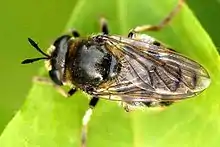Microdon analis
Microdon analis, is a species of hoverfly. It is found in the Palearctic. The distinctive almost slug-like larvae live in ants nests. The larvae are hemispherical in shape and heavily armoured. They are believed to prey on the eggs and larvae of a number of different ant species, notably Lasius niger and the Formica rufa group. These ants are usually found on heathland.[1] However Schmid (2004) claims that Microdon analis and M. major which are cryptic species have been confused under the name analis. M.major is apparently associated with ants of the genus Formica, the other species, M.analis, with Lasius species.[2]
| Microdon analis | |
|---|---|
 | |
| Scientific classification | |
| Kingdom: | |
| Phylum: | |
| Class: | |
| Order: | |
| Family: | |
| Genus: | |
| Species: | M. analis |
| Binomial name | |
| Microdon analis (Macquart, 1842) | |
| Synonyms | |
Description
External images For terms see Morphology of Diptera
Wing length 6·75-8·25 mm. 3rd antennomere about twice as long as 2nd. Tergite 3 without dusting. Tarsae 1 tarsomere 2 shorter than wide. Tibiae 2 with a narrow black ring. Ocellar triangle shiny. The male genitalia are figured by Doczkal & Schmid (1999).[3] See references for determination [4][5][6][7]
Distribution
Palearctic Scandinavia South to the Mediterranean basin. Ireland East through Europe into Russia, the Russian Far East and Siberia and on to the Pacific coast. Mongolia. [8][9]
Biology
Habitat: Quercus, Pinus, Fagus, Picea, Betula forest with fallen trees. Adults are not known to visit flowers to feed but settle on foliage. The flight period is May to July.
References
- Stubbs, Alan E. & Falk, Steven J. (1983). British Hoverflies: An Illustrated Identification Guide. British Entomological & Natural History Society. pp. 253, xvpp.
- Schmid, U. (2004a) Microdon rhenanus and Microdon eggeri var. major (Diptera, Syrphidae) revisited. Volucella, 7: 111-124.
- Doczkal, D. & Schmid, U. (1999) Revision der mitteleuropäischen Arten der Gattung Microdon Meigen (Diptera, Syrphidae). Volucella, 4: 45-68.
- Van Veen, M. (2004) Hoverflies of Northwest Europe: identification keys to the Syrphidae. 256pp. KNNV Publishing, Utrecht.addendum
- Van der Goot,V.S. (1981) De zweefvliegen van Noordwest - Europa en Europees Rusland, in het bijzonder van de Benelux. KNNV, Uitgave no.32: 275pp. Amsterdam.
- Bei-Bienko, G.Y. & Steyskal, G.C. (1988) Keys to the Insects of the European Part of the USSR, Volume V: Diptera and Siphonaptera, Part I. Amerind Publishing Co., New Delhi. ISBN 81-205-0080-6.
- Coe, R.L. (1953) Diptera: Syrphidae. Handbks.ident.Br.insects, 10(1): 1-98. R.ent.Soc.London. pdf
- Fauna Europaea
- Peck, L.V. (1988) Syrphidae. In: Soos, A. & Papp, L. (eds.) Catalogue of Palaearctic Diptera, 8: 11-230. Akad.Kiado, Budapest.